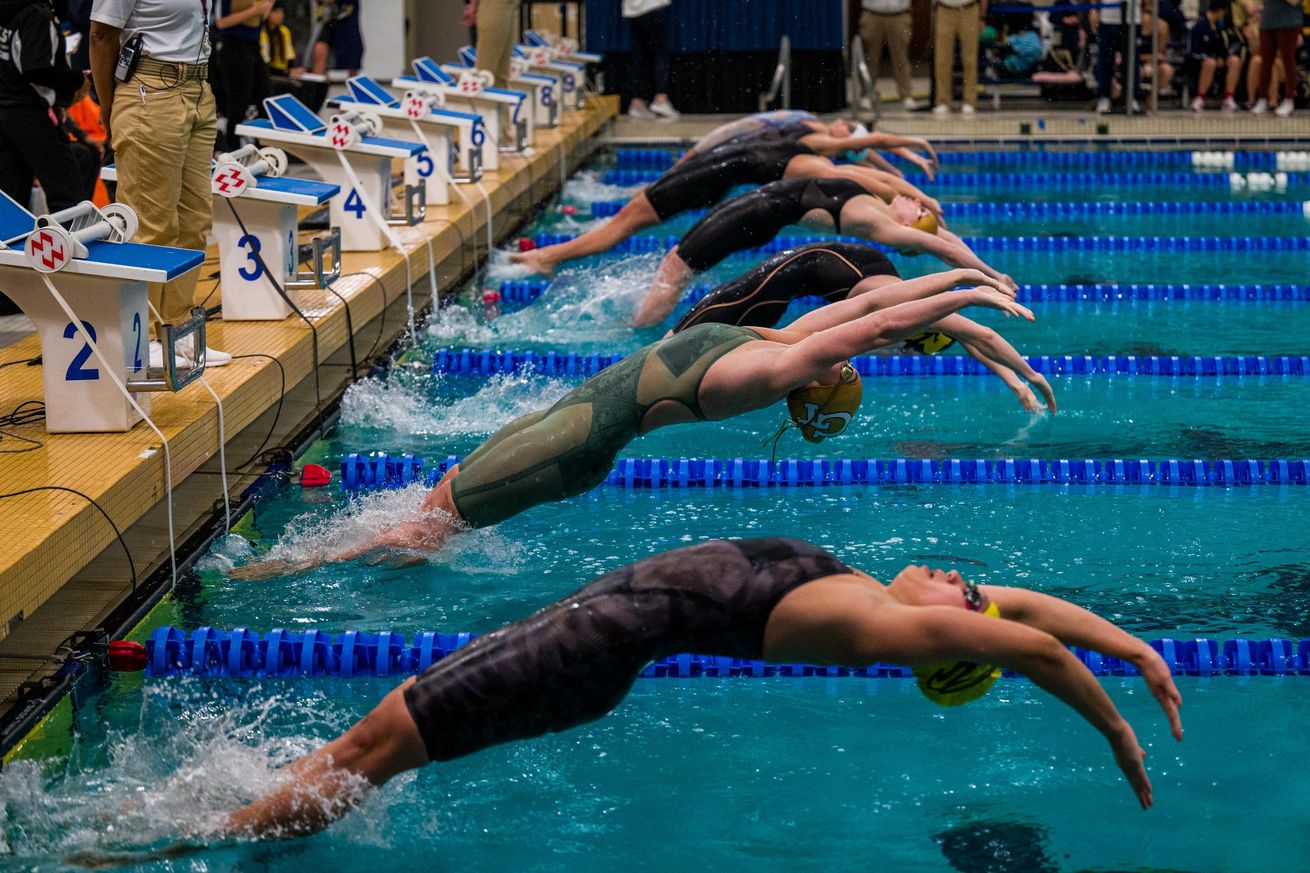
Using the psych sheet and some normally-distributed simulations to take a look at Tech’s chances at a title.
Hello, fan of ACC swimming and diving and/or person interested in esoteric sports analytics! Thank you for clicking over to this impromptu blog post. I have long been interested in trying to apply an analytical approach to results and outcomes in the corner of the sports world in which I am most personally familiar, swimming and diving. During my preparation for From the Rumble Seat’s weekly Scions of the Southland podcast, I had an epiphany for developing a quick little simulation model that would combine a tried-and-true pre-meet scoring tally with a model simulating a swimmer’s taper or diver’s end-of-season improvement. From this, we have a reasonably sensical way to model the outcome of the ACC Swimming and Diving Championship, which starts this morning. In doing so, I plan to identify some of Tech’s names to watch for in this post, as well as the team-level outcomes for Tech’s opponents.
Swimming and Diving Scoring — An Overview
It is likely that swimming and diving most often crosses the mind of the average sports fan during the Summer Olympics. During one glorious week, the entire world turns their attention to the pool as the United States looks to vanquish all challengers. There is a team dynamic to the duels in the pool — counting medals matters. The prototypical sports fan almost certainly pays next to no attention to results of off-year world championships, let alone a typical grand prix meet — the stakes are not tangible, outside of general interest in seemingly-superhuman individual achievement. However, college swimming takes the hum-drum monotony of off-year swimming and tilts it back into the model we know and love — our team (Georgia Tech, of course) versus all comers. Meets with stakes, particularly conference and NCAA championships, make for riveting action. The tension in team competition — high school, College Club, or NCAA — crescendos into the 400 Freestyle Relay, traditionally the last event of a championship swim meet, which is so often an electric cap to a meet of solid swimming, particularly when a meet is closing to a tight finish. This begs the question — how does one know the meet is close at the end? In this case, we start with scoring, presented in the table below:
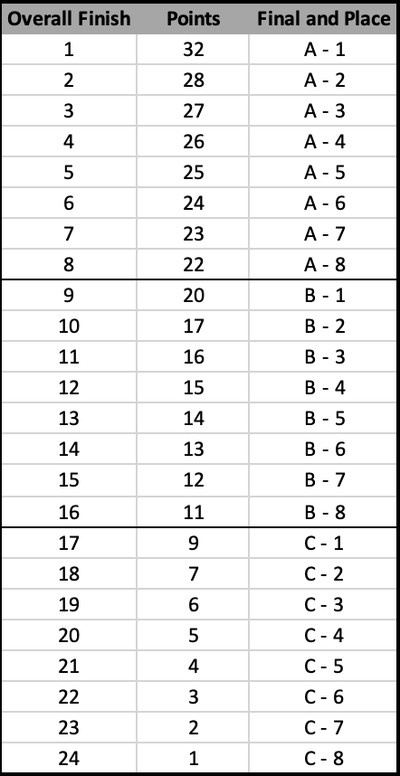
Jake Grant
Putting aside the quick Excel formatting (as formatting tables in the window used to write stories here at FTRS is exceedingly challenging and I had to run the psych sheet through a PDF converter to make it workable), one can see the general shape of the scoring system. The top finisher in each final receives a few points more than the second place finisher, and points descend by one per place from there, with a similar drop off between finals. For most individual events, a preliminary is held in which the top 24 swimmers or top 8 divers advance to a final. In finals, swimmers only score within their own final, i.e., a swimmer in the C final cannot outscore a B final swimmer, even if their final time is faster than the B finalist. Of note, points for relays are doubled, and these events (and the 1650 Freestyle) are swum as timed finals, i.e., an early heat entry can outscore a final heat entry. Preliminaries are generally contested in the morning, with finals in the evening.
Simulating Tapering and Improvement
Based on studies from the National Library of Medicine, 3% performance improvement is a generally accepted rule of thumb following a taper. For the purposes of diving, a similar improvement was assumed. Taper time and scoring improvements were assumed to be normally distributed around a mean of 3%, with a standard deviation assuming a 5% chance each of a result improvement better than 6% or a negative result. 1,000 simulations were run, with the resulting place and associated points averaged to develop an expected points metric.
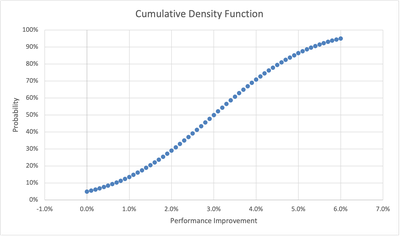
Jake Grant
Tech Results and Athletes to Watch
Men
Among the men, the headline name is Max Fowler, a sophomore diver. Fowler qualified for NCAAs in both the 1 meter and 3 meter diving events last year, and he enters the meet at the top of the psych sheet for both events this week, as well. He ranks first in both in the simulation results, as well as second for platform diving. Of note, platform diving entries are somewhat inconsistent, with several schools having no athletes with entry scores, so simulations are bound to be a bit off there. Overall, Fowler represents about a sixth of all points expected to be scored by Tech at the meet, and the preliminary 3 meter, 1 meter, and platform diving events are this morning, Wednesday, and Friday, respectively.
Among the swimmers, Berke Saka, a senior from Turkiye, is expected to be the highest scorer on the men’s side. Saka is a three-time NCAA participant, an Olympian from summer 2024, and he is expected to participate in five individual events in addition to relays. Among these, Saka projects to be an A-finalist in the 200 Individual Medley and 200 Backstroke, contested Wednesday and Saturday, respectively, with other swims including the 100 Butterfly (Thursday), 200 Freestyle (Thursday), and 100 Backstroke (Friday). Additionally, Leandro Odorici, a senior from Brazil and a participant in last year’s NCAAs, slots in as a potential B-finalist in the 100 Breaststroke and 100 Freestyle (Friday and Saturday), while Mert Kilavus and Lukas Vetkoetter (1650 Freestyle, Saturday) along with Joao Caballero (100 Breaststoke, Thursday) are each potential B-finalists. Among the relays, all of Tech’s entries are projected to finish between eighth and eleventh.
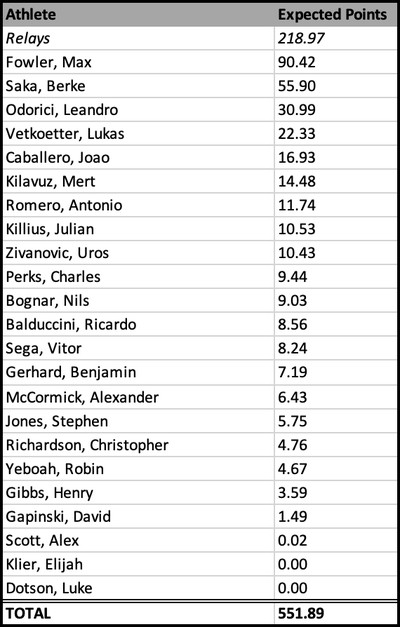
Jake Grant
Women
A similar story emerges among the women, with a diver leading the way. Like Fowler, Anna Bradescu is seeded highly in the platform diving event and is projected to finish first overall, though many other schools’ entries do not have a posted seed. Bradescu is a fifth year student and has competed in NCAAs in all three events at least once, including all four years in platform diving. Women’s 1 meter, 3 meter, and platform diving will be contested this morning, Thursday, and Saturday.
Sophomore Mary Grace Guzzino leads the projected swimmer results, thanks mainly to a strong 1650 Freestyle seed time (contested Saturday). Sabyne Brisson, also a sophomore, if seeds hold, is projected to finish in the points in both the 100 and 200 Breaststroke (Friday and Saturday). Tech’s relays are all seeded between ninth and twelfth.
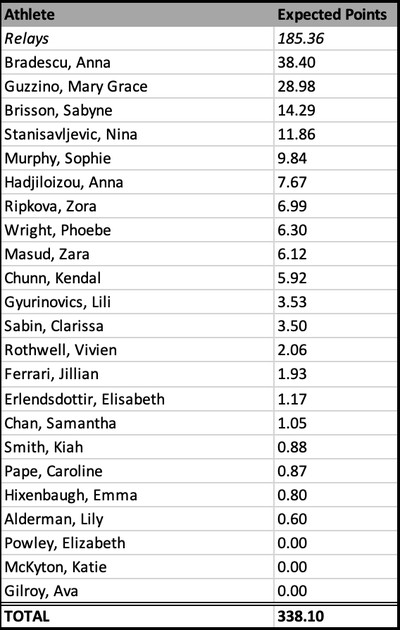
Team Results — Men
Heading into the meet, 9 of the 13 swimming and diving men’s teams (Miami has not had men’s swimming for several decades; Notre Dame’s is suspended for the season) are ranked in the Coaches Poll Top 25, with newcomer SMU also receiving votes; Tech is currently ranked 21st, the ninth highest among ranked ACC teams. Based on projected finish, both the West Coast newcomers slot into the top 4, with Cal edging out Louisville for the conference title despite not being projected to score any diving points. Defending champ NC State rounds out the projected top three finishers, and all four are currently 11th or better in the Coaches’ Poll. With several teams clustered between 500 and 600 points, Tech could reasonably be expected to finish between seventh and tenth in the meet, depending on how things shake out. Tech finished ninth in 2024, and a similar finish would represent a decided improvement year-over-year, given the addition of excellent Cal and Stanford programs.

Jake Grant
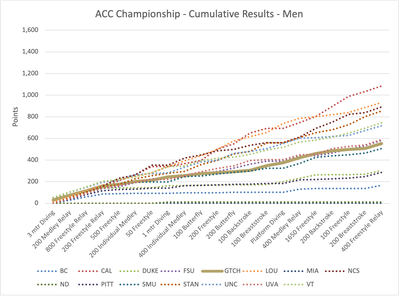
Jake Grant
Team Results — Women
The women’s side of the ledger is quite a bit more top-heavy. Defending conference and national champions (and psuedo-USA Swimming senior national team) Virgnia is the runaway favorite to repeat, with Stanford surprisingly expected to sit their top swimmers for the last two days of scoring competition, which has been accounted for in the model. This opens the door for a quintet consisting of North Carolina, Louisville, and Cal (the latter two of whom are projected to finish within a point of each other) to make the race for second place tight.
As for Tech, the Jackets are projected to finish tenth. Like the fight for second place, they are also in a tight cluster, ranking about 20 points clear of the logjam of Pitt, Notre Dame, and Miami and about 50 points behind Virginia Tech. Without Cal, Stanford, and SMU in the conference, the women finished ninth last year.

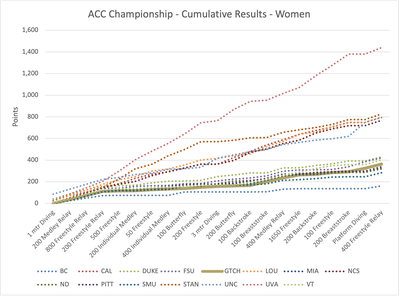
Jake Grant
All in all, this was mostly an exercise in figuring out how to think about this meet, while also getting familiar with the landscape of the competition. We’ll take in the results from this year and look to refine the analysis next year, as it as been pretty interesting to put together. In the meantime, the meet is broadcast live through Saturday on ACC Network Extra. In addition, keep an eye out for NCAAs in March, with the women competing March 19-22 and the men in action March 26-29 in Federal Way, Washington.
